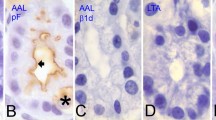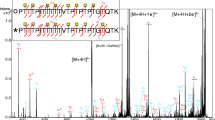Summary
4-Cl-5-Br-3-indolyl-β-D-fucoside (IbF) was tested in histochemical and bio-chemical experiments. Sections from differently treated parts of the small intestine of suckling and adult rats, of jejunum of adult hamsters, guinea pigs, cooks, monkeys, of human jejunal biopsies, of kidney of suckling and adult rats, adult monkeys, guinea pigs and hamsters, and of some other rat organs were used in histochemical experiments. Neutral and acid β-D-galactosidases prepared from homogenates of the small intestine of suckling rats by chromatography on Sephadex G 200 were used in biochemical experiments.
The recommended medium for histochemical studies consists of 0.1 M citrate phosphate buffer pH 6 (brush border enzyme) and pH 4 (lysosomal enzyme), 3.6·10−4M IbF and 3.1·10−3 M potassium ferri- and ferrocyanide.
IbF is split quite efficiently by the brush border β-D-galactosidase (=lactase) and the recommended histochemical method with IbF at pH 6 is the method of choice in studies concerned with the localization of intestinal lactase. In unfixed cold microtome sections the brush border activity can be easily detected within 15–240 minutes, depending on the lactase activity of the studied sample. In this study this activity was shown to be present in the brush border of enterocytes in the upper part of crypts reaching its maximum in differentiated enterocytes covering the sides and tops of villi in the small intestine of suckling (the highest activity) and adult rats (3–4x lower activity according to the time of appearance of the staining), and of human, monkey and hamster jejunum. In the cock jejunum traces of brush border staining were seen only after 24 hours of incubation. In enterocytes of patients with celiac sprue the brush border activity was very much reduced in dependence on the stage of the disease. Brush border staining along with a diffuse cytoplasmic reaction was found in the proximal convoluted tubules of the monkey kidney. The question of localization of enzyme activity splitting IbF in the monkey kidney deserves further investigation.
IbF is also split by isolated intestinal acid β-D-galactosidase and histochemically a positive reaction was found in lysosomes of many cells displaying a high activity of β-D-galactosidase when IbF was used in the recommended medium of pH 4. The use of aldehyde fixation (glutaraldehyde is to be preferred) is a prerequisite for the assessment of this lysosomal localization. The lysosomal activity splitting IbF is not firmly bound structurally and escapes from cold microtome sections prepared from unfixed tissue samples into the incubation solution.
The recommended method is also very suitable for processing zymograms and immunoprecipitation lines of lactase with antisera obtained by Ouchterlony's technic and by immunoelectrophoresis.
Similar content being viewed by others
References
Esterly, J. R., Standen, A. C., Pearson, B.: The histochemical demonstration of intestinal β-D-fucosidase with 5-bromo-4-chloroindole-3-yl-β-D-fucopyranoside. J. Histochem. Cytochem. 15, 470–474 (1967).
Holt, S. J.: The value of fundamental studies of staining reactions in enzyme histochemistry, with reference to indoxyl methods for esterases. J. Histochem. Cytochem. 4, 541–552 (1956).
—, Withers, R. F. J.: Cytochemical localization of esterases using indoxyl derivatives. Nature (Lond.) 170, 1012–1014 (1952).
—: Studies in enzyme cytochemistry. V. An appraisal of indigogenic reaction for esterase localization. Proc. roy. Soc. B 148, 520–532 (1958).
Kerry, K. R.: Intestinal disaccharidase activity in a monotreme and eight species of marsupials (with an added note on the disaocharidases of five species of sea birds). Comp. Biochem. Physiol. 29, 1015–1022 (1969).
Kraml, J.: Immunochemical studies on the β-galactosidases and sucrases of the small intestine of the rat. 7th inter. Congr. clin. Chem. Geneva/Evian 1969; Vol. IV: Digestion and intestinal absorption, p. 81–92. Basel-München-New York: Karger 1970.
—, Koldovský, O., Heringová, A., Jirsová, V., Kácl, K., Ledvina, M., Pelichová, H.: Characteristics of β-galactosidases in the mucosa of the small intestine of infant rat. Physicochemical properties. Biochem. J. 114, 621–627 (1969).
Levvy, G. A., McAllan, A.: β-D-fucosidase in the limpet, Patella vulgata. Biochem. J. 87, 206–209 (1963a).
—: Mammalian fucosidases. 3. β-D-fucosidase activity and its relation to β-D-galaetosidase. Biochem. J. 87, 361–367 (1963b).
Lojda, Z.: The demonstration of myeloperoxidase in paraffine sections with a new method. Čs. Pat. 3, 31–33 (1967, in Czech).
-Introduction to enzyme histochemistry. Part I. Brno: Czechoslovak Society of Histo- and Cytochemistry, 1968 (in Czech).
—: Indigogenic methods for glycosidases. I. An improved method for β-D-glucosidase and its application to localization studies of intestinal and renal enzymes. Histochemie 22, 347–361 (1970a).
—: Indigogenic methods for glycosidases. II. An improved method for β-D-galactosidase and its application to localization studies of the enzymes in the intestine and in other tissues. Histochemie 28, 266–288 (1970b).
- Histochemical detection of enzymes. Part III. Brno: Czechoslovak Society of Histo- and Cytochemistry 1970c [in Czech].
Malathi, P., Crane, R. K.: β-glucosidase of hamster intestinal brush border membrane. Biochim. biophys. Acta (Amst.) 173, 245–256 (1969).
Nordström, Ch., Koldovsky, O., Dahlqvist, A.: Localization of β-galactosidases and acid phosphatase in the small intestinal wall. Comparison of adult and suckling rat. J. Histochem. Cytochem. 17, 341–347 (1969).
Semenza, G.: Intestinal oligosaccharidases and disaccharidases. In: Handbook of Physiology, ed. by C. F. Code. Alimentary Canal, chapt. 119, p. 2547–2566. Washington, D.C.: Amer. Physiol. Soc. 1968.
Swaminathan, N., Radhakrishnan, A. N.: Purification and properties of lactase from monkey kidney. Biochim. biophys. Acta (Amst.) 191, 322–328 (1969).
Wallenfels, K., Fischer, J.: Untersuchungen über milchzuckerspaltende Enzyme. X. Die Lactase des Kälberdarms. Hoppe-Seylers Z. physiol. Chem. 321, 223–245 (1960).
Zoppi, G., Shmerling, D. H.: Intestinal disaccharidase activities in some birds, reptiles and mammals. Comp. Biochem. Physiol. 29, 289–294 (1969).
Author information
Authors and Affiliations
Rights and permissions
About this article
Cite this article
Lojda, Z., Kraml, J. Indigogenic methods for glycosidases. Histochemie 25, 195–207 (1971). https://doi.org/10.1007/BF00305938
Received:
Issue Date:
DOI: https://doi.org/10.1007/BF00305938




